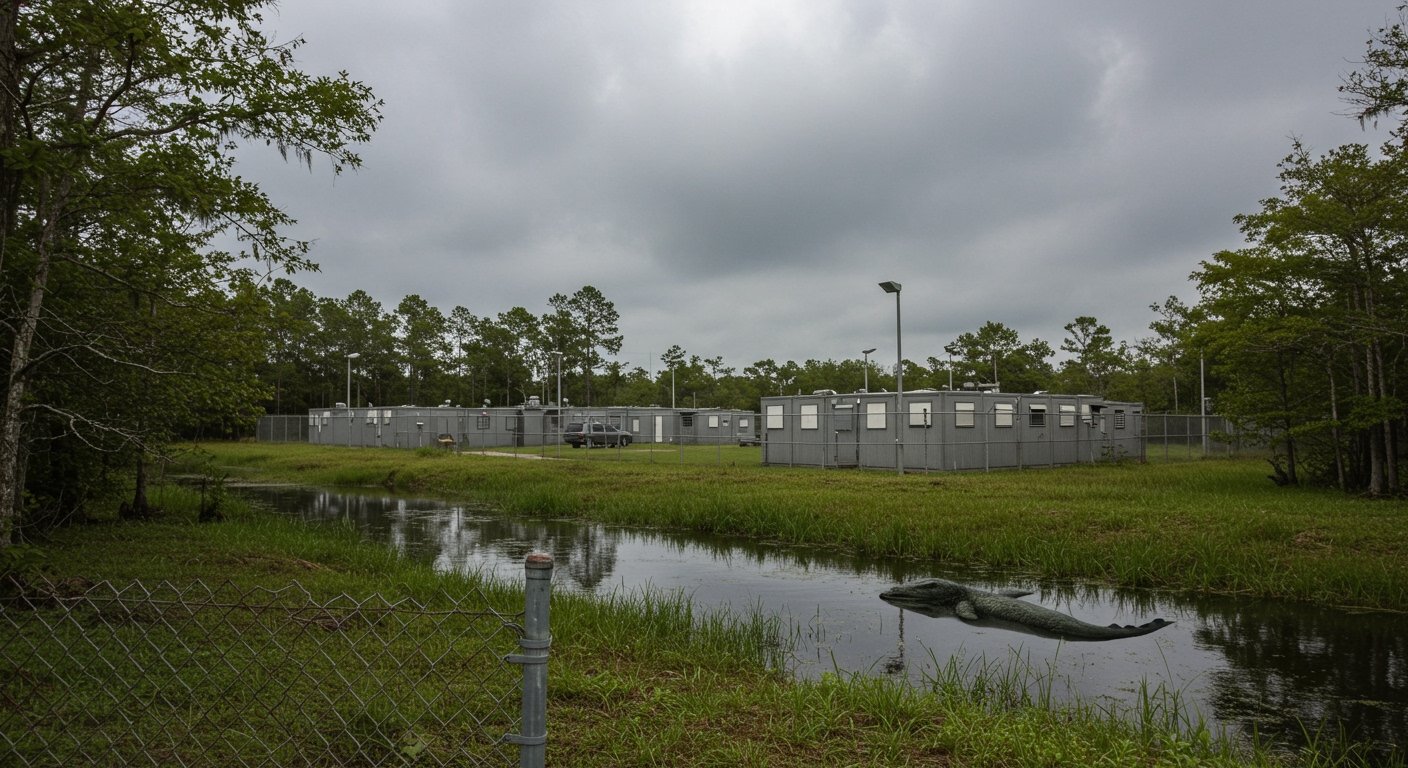WASHINGTON/SOUTHERN FLORIDA – U.S. President Donald Trump is slated to visit a newly established temporary migrant detention center in southern Florida on Tuesday, July 1, 2025, a move that underscores his administration’s intensified focus on increasing immigration detention and deportations.
The facility, situated in a remote area of the vast Florida Everglades, has already acquired the informal moniker “Alligator Alcatraz.” This colorful nickname stems from its isolated location within an environment known for its challenging natural landscape, including the presence of alligators, crocodiles, and pythons. Intriguingly, a Florida official reportedly noted that these natural elements provide inherent barriers that could potentially reduce the overall security requirements for the site.
Underlining the Administration’s Immigration Strategy
The planned visit highlights President Trump’s consistent emphasis on curbing illegal immigration through increased detention and subsequent deportation. This approach, he states, is a necessary response to the significant levels of illegal border crossings that occurred during the previous administration. The visit is expected to draw national attention, serving as both a symbolic affirmation of his immigration policies and a practical assessment of the new detention capabilities.
According to government data, the number of individuals held in federal immigration detention has seen a substantial increase since the beginning of Mr. Trump’s term. Data indicates that by June 15, 2025, this number had reached 56,000 individuals, a notable rise from the 39,000 recorded at the start of his presidency. This significant surge in detainee population has reportedly necessitated the administration’s efforts to secure and establish additional detention space, of which the southern Florida facility is an example.
The ‘Alligator Alcatraz’ Location and Security
The choice of a remote Everglades location for the new temporary center presents unique operational considerations. The “Alligator Alcatraz” nickname, while informal, points to the natural isolation of the site. The surrounding environment, teeming with dangerous wildlife, indeed creates a natural perimeter, a point acknowledged by a Florida official who suggested this could translate to reduced conventional security needs compared to more accessible locations.
However, establishing and operating a large-scale facility in such an environment also presents logistical challenges, from transportation and supply lines to ensuring the safety and well-being of both detainees and staff in proximity to potentially dangerous animals. The details regarding the operational setup and long-term plans for the site are expected to be further illuminated during or after the presidential visit.
Key Figures and Visit Dynamics
President Trump is anticipated to be accompanied by Secretary of Homeland Security Kristi Noem during the tour. Secretary Noem reportedly requested the President’s visit, suggesting the administration views the opening of this facility as a significant development in its broader immigration enforcement strategy and one that warrants high-level attention. The presence of the Secretary underscores the Department of Homeland Security’s central role in managing the increase in federal immigration detention capacity.
The visit is likely to involve briefings on the facility’s operations, capacity, and the demographics of the individuals expected to be held there. It will also serve as a platform for the President and Secretary Noem to reiterate the administration’s policy objectives regarding border security and immigration enforcement.
Policy Context and Future Implications
The expansion of immigration detention capacity, exemplified by the opening of facilities like the one President Trump is set to visit, is a direct consequence of the administration’s policy choices and the subsequent increase in detention numbers. The government data showing the jump from 39,000 to 56,000 detainees by June 15, 2025, illustrates the tangible impact of these policies.
Securing more detention space is a stated priority for the administration as it seeks to process and deport a larger number of individuals. The visit to the southern Florida site, therefore, is not merely ceremonial but a key event aimed at showcasing progress on a central tenet of the President’s agenda.
While the remote Everglades location and its unique challenges, highlighted by the “Alligator Alcatraz” nickname and the Florida official’s comments on natural barriers, add a distinctive element to this facility, its primary significance lies in its role as a new piece of the expanding infrastructure dedicated to federal immigration detention under the Trump administration.
The visit on Tuesday, July 1, 2025, is expected to further spotlight the administration’s determined pursuit of its immigration policies and the operational measures being taken to support them.






